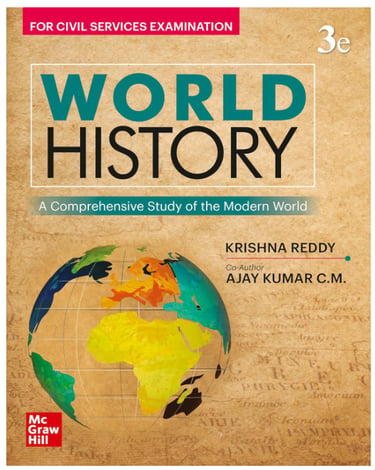World War 2: A Comprehensive Analysis for UPSC Aspirants
Explore the crucial aspects of World War 2, including its causes, significant events, and aftermath, tailored for UPSC and MPSC Civil Service Examinations preparation. Dive deep into this important topic in world history to enhance your understanding and exam readiness.
WORLD HISTORY
Introduction
World War II (1939–1945) was one of the deadliest and most widespread conflicts in human history, involving more than 30 countries and resulting in the deaths of approximately 70–85 million people. It was fought between two major military alliances: the Axis Powers, primarily led by Germany, Italy, and Japan, and the Allies, headed by the United States, the Soviet Union, the United Kingdom, and China.
The war not only reshaped global geopolitics but also had far-reaching socio-economic and cultural impacts, setting the stage for the Cold War, the rise of the United States and the Soviet Union as superpowers, and the establishment of international institutions such as the United Nations (UN) and the World Bank. For UPSC aspirants, understanding World War II is essential for grasping modern world history, geopolitics, and international relations.
Causes of World War II
The origins of World War II can be traced back to multiple interconnected factors:
1. Treaty of Versailles (1919):
The Treaty of Versailles, which ended World War I, imposed harsh penalties on Germany, including massive reparations, territorial losses, and military restrictions. This caused widespread resentment in Germany and contributed to the rise of Adolf Hitler and the Nazi Party, who promised to overturn the humiliating conditions imposed by the treaty.
2. Rise of Fascism and Militarism:
Germany: Under Hitler’s leadership, Germany adopted an aggressive foreign policy aimed at expanding its territory. Hitler's ideology of Lebensraum (living space) pushed for territorial expansion, primarily into Eastern Europe.
Italy: Led by Benito Mussolini, Italy sought to restore the Roman Empire's former glory through military expansion, notably in Ethiopia and the Mediterranean.
Japan: Japan, under militaristic rule, sought to dominate Asia, especially China and the Pacific region. Its expansionist ambitions were driven by the need for natural resources.
3. Failure of the League of Nations:
Established after World War I to maintain peace, the League of Nations failed to prevent aggression by the Axis Powers. The League was unable to enforce its resolutions or curb the militarism of countries like Japan (invasion of Manchuria), Italy (invasion of Ethiopia), and Germany (remilitarization of the Rhineland).
4. Great Depression (1929):
The global economic downturn led to political instability in many countries, particularly in Germany, where unemployment and poverty fueled discontent. The economic hardships also led to increased militarism in countries like Japan, which sought to secure resources through imperial expansion.
5. Appeasement Policy:
The policy of appeasement, followed primarily by Britain and France in the 1930s, allowed Hitler to expand German territory unchecked. The Munich Agreement of 1938, where Britain and France allowed Germany to annex the Sudetenland (a region of Czechoslovakia), is a notable example. This emboldened Hitler, as he saw the Allies’ reluctance to challenge his aggression.
Course of the War
World War II is generally divided into three phases:
1. Phase I: Early Axis Victories (1939–1941):
Invasion of Poland (1939): The war began on September 1, 1939, when Germany invaded Poland. Britain and France declared war on Germany, but they were unable to prevent the rapid German advance.
Blitzkrieg: Germany introduced a new military tactic called Blitzkrieg (lightning war), which involved fast-moving, coordinated attacks by tanks, aircraft, and infantry. This allowed Germany to quickly conquer much of Europe, including Denmark, Norway, Belgium, the Netherlands, and France.
Battle of Britain (1940): After conquering France, Germany attempted to subdue Britain through a massive aerial bombardment known as the Battle of Britain. However, British resistance, aided by the invention of radar, thwarted Hitler’s plans to invade the island nation.
Operation Barbarossa (1941): In June 1941, Germany launched Operation Barbarossa, the invasion of the Soviet Union. Initially successful, the German advance was eventually halted by harsh winter conditions and fierce Soviet resistance.
2. Phase II: The Turning Point (1942–1943):
Pearl Harbor and U.S. Entry (1941): The Japanese attack on Pearl Harbor on December 7, 1941, brought the United States into the war. This dramatically altered the balance of power in favor of the Allies.
Battle of Stalingrad (1942–1943): One of the most significant turning points of the war, the Battle of Stalingrad marked the first major defeat of Nazi Germany. The Soviet victory began the German retreat from Eastern Europe.
Battle of Midway (1942): In the Pacific Theater, the Battle of Midway was a critical victory for the U.S. Navy, which crippled the Japanese fleet and marked the beginning of Japan's decline in the Pacific.
3. Phase III: Allied Victory (1944–1945):
D-Day Invasion (1944): On June 6, 1944, the Allies launched Operation Overlord, the invasion of Nazi-occupied France through the beaches of Normandy. This opened a new front in Western Europe and accelerated the downfall of Nazi Germany.
Fall of Berlin (1945): In April 1945, Soviet forces captured Berlin, leading to the suicide of Adolf Hitler and the unconditional surrender of Germany on May 7, 1945.
Atomic Bombings and Japanese Surrender (1945): After prolonged fighting in the Pacific, the U.S. dropped atomic bombs on the Japanese cities of Hiroshima (August 6) and Nagasaki (August 9). Japan surrendered on August 15, 1945, marking the end of World War II.
Major Consequences of World War II
1. Human and Economic Losses:
World War II resulted in an unprecedented loss of life, with estimates ranging from 70 to 85 million deaths. The war devastated cities, infrastructure, and economies, especially in Europe and Asia. Germany, Japan, and other Axis Powers faced severe consequences, while the Allies, though victorious, also suffered heavy losses.
2. Formation of the United Nations:
In 1945, the UN was established to replace the League of Nations and prevent future conflicts. The UN was designed with stronger mechanisms for international cooperation and conflict resolution, including the Security Council, where the five permanent members (U.S., Soviet Union, China, Britain, and France) hold veto power.
3. Beginning of the Cold War:
The ideological clash between the United States (capitalism and democracy) and the Soviet Union (communism and authoritarianism) intensified after World War II. The Cold War began, leading to a global rivalry that would last for decades, marked by proxy wars, nuclear arms races, and political conflicts.
4. Decolonization:
The war weakened European colonial powers, and after the war, many colonies in Asia and Africa gained independence. India, for example, became independent in 1947, while African countries followed in the 1950s and 1960s. The war significantly contributed to the decline of colonialism and the rise of new nation-states.
5. Rise of the U.S. and U.S.S.R. as Superpowers:
World War II marked the decline of traditional European powers like Britain and France, while the U.S. and the Soviet Union emerged as global superpowers. This led to a bipolar world order dominated by these two nations throughout the Cold War period.
6. Nuclear Age and Arms Race:
The development and use of nuclear weapons by the United States during World War II ushered in the nuclear age. The post-war period witnessed an arms race, especially between the U.S. and the Soviet Union, which culminated in the Cold War's threat of nuclear conflict.
Conclusion
World War II was a pivotal event in world history, reshaping the political, economic, and social landscape of the 20th century. For UPSC aspirants, understanding the war's causes, course, and consequences is crucial for comprehending modern geopolitics, the formation of international institutions, and the post-war global order. It offers critical insights into the evolution of international relations, decolonization, and the onset of the Cold War, all of which continue to influence contemporary global affairs.
In conclusion, World War II's legacy is enduring, influencing the geopolitical strategies of nations, the structure of international organizations, and the pursuit of peace and security across the world.


